from Hara Museum ARC
Auspicious Beauty – Art for the New Year
November 21 (Friday), 2014 – January 4 (Sunday), 2015
Kankai Pavilion (Traditional East Asian Art)
It is the time of year again when we feature paintings and crafts with auspicious imagery to welcome in the New Year. It is an opportunity to gaze upon this aspect of Japanese customs and aesthetics passed down through the ages.
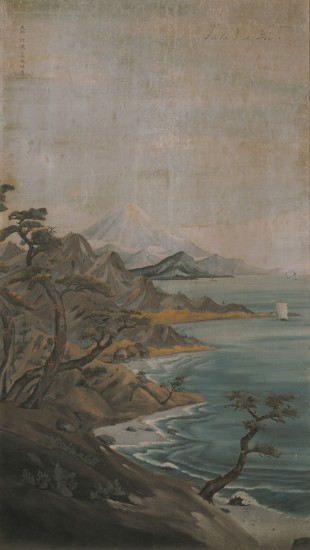
Landscape of Mt. Fuji (detail), Shiba Ko’kan, Edo period
This work by Shiba Ko’kan (1747 -1818) was done when he enthusiastically engaged in oil painting. The words “Sata Fu Dsi” in the top-right corner suggest that this is a scene of Mount Fuji as seen from Satta Pass in Shizuoka. Revered as a sacred mountain since ancient times, Mount Fuji was depicted in a great many paintings for its auspicious symbolism. One might see this landscape as a confluence of traditional and modern aesthetics.
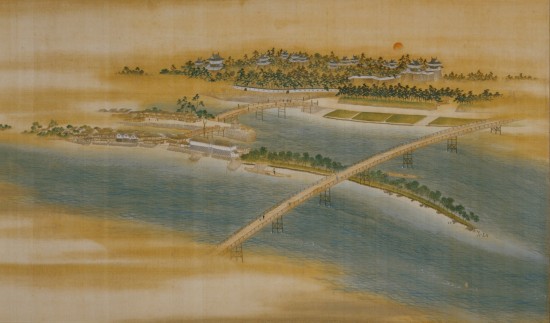
Landscape of Yodo River, Maruyama Okyo, Edo period
This scroll painting, approximately 16-meter long, shows the Yodo River as it flows from Fushimi in Kyoto to Tenmabashi in Osaka. What is attempted here is the depiction of the landscape on both banks of the river as from the boat. The unique perspective and visual sense by which the scenery unfolds on the top and lower banks, the expression of the color of the sky, and the great details in the landscape based his sketch make this a deeply impressive work of art. The scene at the end of the scroll, with its sudden change in viewpoint and the rising sun above Osaka Castle, is imbued with a feeling of hope for future prosperity.
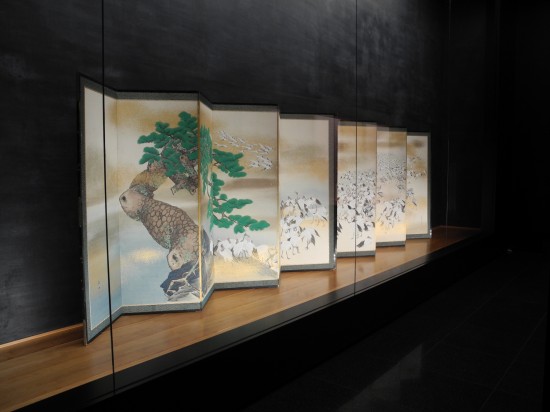
A hundred cranes (left screen), Mori Tetsuzan, Edo period
2015 is the Year of the Sheep. The word “sheep” contains the ideogram for “beautiful,” and thus the theme this time is auspicious symbols and beautiful women.
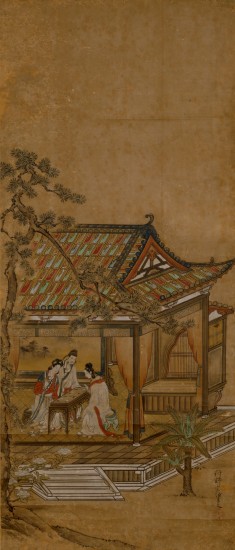
Yang Guifei playing chess (part of a set of twelve hanging scrolls by painters of the Kano school), Kano Sotoku, Edo period
At the start of the early modern era, the Chinese imperial court and its customs was a highly popular subject in painting. Reflecting this taste for foreign exotica, many works were produced with the Tang Emperor Xuan Zong (685-762) as the subject. Yang Guifei (719-756) was Xuan Zong’s favorite concubine. In this picture, two women are playing a game of backgammon while another woman holds a cylinder in her hand. Watching over the women on the side is probably Xuan Zong and one of the women Yang Guifei.
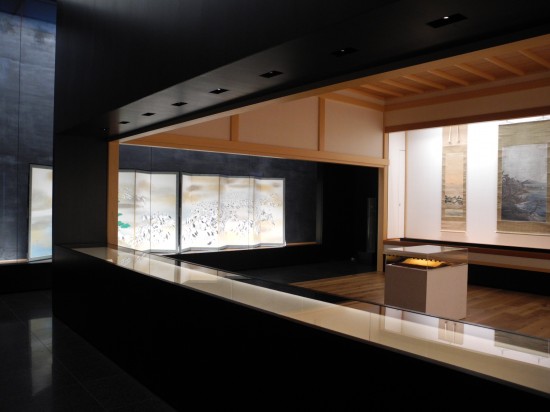
Installation view
Featured Works
Traditional Art: Princess Wangzhao-jun, set of twelve hanging scrolls by painters of the Kano school, Kano Shirojiro Sadanobu, hanging scroll, Edo period / Landscape of Yodo River, Maruyama Okyo, hand scroll, Edo period / Landscape of Mt. Fuji, Shiba Ko’kan, hanging scroll, Edo period / A hundred cranes, Mori Tetsuzan, pair of six-fold screens, Edo period / Seaside landscape with sunrise, Yokoyama Taikan, hanging scroll, Meiji period / Red lacquered Ruyi (Buddhist ritual implement) engraved with auspicious motifs, Qing dynasty and others
Contemporary Art: Edward Kienholz, The Billionnaire Deluxe, 1976/77 / Robert Mapplethorpe, Flower #1-#3, 1977-81 / Noe Aoki, tateyama, 2007 and others
Hara Museum ARC
Address: 2855-1, Kanai, Shibukawa-shi, Gunma 377-0027
Tel 0279-24-6585 Fax 0279-24-0449 E-mail arc@haramuseum.or.jp
Website: http://www.haramuseum.or.jp Mobile site: http://mobile.haramuseum.or.jp
Blog: https://www.art-it.asia/en/u/HaraMuseum_e Twitter: http://twitter.com/HaraMuseumARC
Hours: 9:30 am – 4:30 pm (last entry at 4:00 pm)
Closed: Thursdays and January 1 *Closed temporarily in the event of severe weather.
Admission: General (over 12) 1,100 yen, Students 700 yen (high school and university) or 500yen (elementary and junior high), Free for Hara Museum members; 10% discount for a group of 20 or more; Combination ticket for Hara Museum ARC and Ikaho Green Bokujo (except during Golden Week): General 1,800 yen; Students 1,500 yen (high school and university) or 1,400 yen (junior high), 800 yen (elementary) *Children must be accompanied by an adult.
Getting There: By train: Take the Joetsu Shinkansen to Takasaki, change to the Joestu Line, and disembark at Shibukawa. From Shibukawa, ARC is 10 minutes away by taxi or 15 minutes by bus (take the Ikaho Onsen bus to ″Green Bokujo Mae″). By car: 8 kilometers (about 15 minutes) from the Kan-etsu Expressway Shibukawa Ikaho Interchange (in the direction of Ikaho Onsen).
